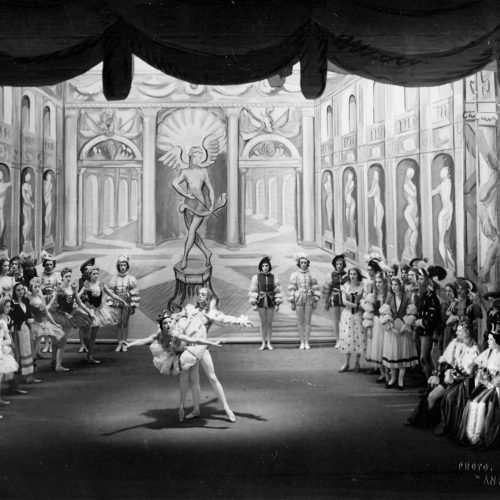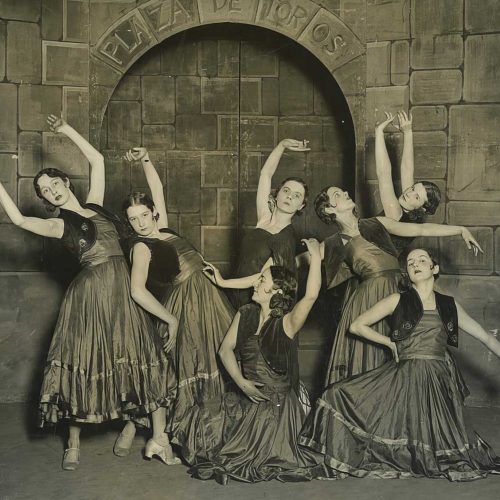By Clare Mac Cumhaill and Rachael Wiseman, philosophers
It wasn’t only in ballet that women were leading British ballet forward. But in philosophy too, four redoubtable women change the face of the subject.
G. E. M. Anscombe (1919 – 2001), Philippa Foot (née Bonsanquet) (1920 – 2010), Mary Midgley (née Scrutton) (1919 – 2018) and Iris Murdoch (1919 – 1999) were born just after the First World War and went to Oxford University to study philosophy just before the outbreak of the Second. They met there and after the war returned to Oxford where they formed a small but loud chorus of voices against the dominant moral philosophy of the day, which they viewed as false and corrupt. In particular, they argued that its consequentialist and non-cognitivist character (rooted in logical positivism) left philosophers unable to say, as they thought they must, that the Nazis had been objectively wrong.
All four went on to have long philosophical careers, flourishing in an environment that was, and is, hostile to women. Between them they published a great number of ground-breaking books and articles, including Anscombe’s Intention and Modern Moral Philosophy, Foot’s Moral Beliefs, Moral Arguments and Natural Goodness, Midgley’s Animals and Why they Matter, and Murdoch’s The Sovereignty of Good. Though they wrote on a wide range of philosophical topics – history of philosophy, metaphysics, philosophy of mind, philosophy of science and political philosophy – moral philosophy remained central to their work. Iris Murdoch, of course, became known to a wider public as the author of many much admired novels, in which philosophical reflections played a prominent part.
In 1937, the Somerville principal greeted new students at the women’s college with a speech that included the warning, ‘the women are on still on probation in this university’. Women made up around 16% of the student body and had only been permitted to take degrees from Oxford since 1921. The change had been fiercely resisted by the male undergraduate population, and in Cambridge the same proposal was voted down and effigies of ‘Bluestockings’ on bicycles were burned in the streets. It would be another 26 years before Cambridge admitted women as equals.
Philippa Foot had faced the biggest struggle to secure her place. Granddaughter of the American president, Grover Cleveland, and raised to marry into the British aristocracy, Philippa Foot had been home schooled. Her mother, Esther, feared that university education would ruin her marriage prospects – ‘Don’t worry dear, she doesn’t LOOK clever’, was the only reassurance Esther’s friend could offer. The other three were from middle class and, in different ways, progressive families, and faced no such opposition. Midgley’s Aunt Jane had studied history at Girton College, Cambridge, before the First World War, and three of her mother’s Aunts (Jeanie, Nan and Sarah) had University diplomas from the 1880s (though not, of course, degrees).
Anscombe, Foot, Midgley and Murdoch met during their undergraduate years. Murdoch and Midgley became close friends as soon as they arrived, helping each other through Latin composition – their male counterparts’ school education had drilled them for this while Murdoch’s and Midgley’s not. Anscombe was a frequent visitor to Somerville and joined the pair for long conversations about Plato and Hobbes. Murdoch was introduced to Foot in her final year at Somerville, by their tutor Donald MacKinnon. The pair became instant friends.
Their undergraduate years spanned the Munich Crisis, the Phoney War, and the Blitz. Conscription for single men aged between 20 and 22 was introduced in May 1939 and the National Service Act followed in September, imposing conscription on all men aged between 18 and 41. Conscription for unmarried women did not come until the end of 1941, so while Oxford was emptied of young men (Murdoch speaks of them as being ‘as rare as butterflies in March’) the women were allowed to continue their education unimpeded. By 1940, women made up almost 30% of the student intake, and almost all the male undergraduates left after one or two years of study.
The removal of the young men created a unique situation for undergraduate women, one that was especially keenly felt in a discipline that valorises a gendered set of character traits and dispositions. Instead of argumentative young men, the four women were surrounded by much older dons, conscientious objectors and refugee scholars. Writing in 2013, Mary Midgley responded to the question: how did four such well-known women philosophers emerge from Oxford soon after the war, when so few women get through in this discipline, even today?
“As a survivor from the wartime group, I can only say: sorry, but the reason was … that there were fewer men about then. The trouble is not, of course, men as such – men have done good enough philosophy in the past. What is wrong is a particular style of philosophising that results from encouraging a lot of clever young men to compete in winning arguments. … By contrast, in those wartime classes – which were small – men (conscientious objectors etc) were present as well as women, but they weren’t keen on arguing. It was clear that we were all more interested in understanding this deeply puzzling world than in putting each other down. That was how [we]. all came to think out alternatives to the brash, unreal style of philosophising – based essentially on logical positivism – that was current at the time.” (The Guardian, 28 November 2013)
On graduating, Midgley, Murdoch and Foot moved to London to do war work, Murdoch and Foot sharing a flat just off Victoria Street. Midgley worked for Betty Ackroyd (later Dame Elizabeth Ackroyd) in the newly established Ministry of Production. Foot was an economics research assistant at the British Institute for International Affairs at Chatham House, where she attended lectures from Bertha Bracey (head of both the Friends Committee for Refugees and Aliens and the Central Department for Interned Refugees) and Martha Mead (then executive secretary of the Committee on Food Habits). Murdoch became an assistant principal in the Treasury before taking a post-war job with the UN Relief and Rehabilitation Administration, which took her to Belgium and Austria to assist with the resettlement of the millions of displaced people. Anscombe won the Sarah Smithson studentship at Newnham College Cambridge and married Peter Geach, a fellow Catholic convert, philosopher, and conscientious objector. She soon after had the first of her seven children. While at Cambridge, Anscombe became a close friend and philosophical interlocutor of Ludwig Wittgenstein and later went on to become extremely influential as one of Wittgenstein’s literary executors and translator of some of his most important work, including the Philosophical Investigations. When Murdoch won the same studentship in 1947, Anscombe arranged for her to meet Wittgenstein.
In 1945, Philippa Foot married M.R.D. Foot and returned to Oxford, he to finish the undergraduate study that had been interrupted by the war, her to take up a teaching post in Somerville College. They moved to Park Town, where Mary Midgley was already living, having returned to Oxford to work as an assistant to Gilbert Murray and work toward a PhD on Plotinus. Soon, Murdoch secured a job at St Hugh’s and moved in with the Foots. Anscombe was offered a post at Somerville – Foot threated to resign hers if her friend was not appointed – and Anscombe and her growing family moved to nearby St John’s Street.
Moral Philosophy in post-war Britain was dominated by the young men who had returned from war to take up the conversations begun in 1930s. In 1936, A. J. Ayer’s Language, Truth and Logic had introduced the logical positivism of the Vienna circle to British philosophers and the public. He argued for a strict separation between the fact-stating language of the empirical sciences, and language of ethics, religion, aesthetics and poetry. Only the sentences of the empirical sciences were truth-evaluable. Ayer reduced moral judgment to the status of expression of emotion, and moral argument to disagreement about personal preference. In the post-war period, moral philosophers operated within the logical positivist’s framework. Richard M. Hare, an exact contemporary of Midgley and Murdoch, was the dominant moral philosopher at the time. He stayed true to the claim that moral judgments are not fact-stating or truth-evaluable by defending a view called ‘moral prescriptivism’, according to which moral judgments are prescriptions. Hare had spent much of the war in a Japanese prisoner of war camp, where he had come to believe that objective moral truth was a chimera: each man must generate his own set of moral prescriptions for himself, and then hold his own behaviour to account as against those principles. Another man’s principles could be criticised but only on grounds of irrationality or inconsistency.
Philippa Foot would later recall her immediate rejection of Hare’s position. Haunted by news of the concentration camps, his noncognitivism deprived her of the ability to say to a Nazi: ‘You were wrong and we were right’. Writing in 2016, Mary Midgley recalled their Park Town conversations:
“What, for me, makes the unanimity-story still important is a persisting memory of the four of us sitting in Philippa’s front room and doing our collective best to answer the orthodoxies of the day, which we all saw as disastrous. As with many philosophical schools, the starting-point was a joint ‘NO!’. No (that is) at once to divorcing Facts from Values, and – after a bit more preparation – also No to splitting mind off from matter. From this, a lot of metaphysical consequences would follow.”
The next forty years of philosophical work for each of the four women can be viewed as an attempt to articulate those consequences. Central to that project was the revival of Aristotelian Virtue ethics, which had fallen into neglect in the nineteenth century. Virtue ethics is a moral philosophy that begins from the observation that human beings are living organisms and, as for all living things, there are norms internal to the species by which an individual can be said to flourish or suffer. It is therefore possible to say that, as a matter of objective fact, a particular human life is going well or badly. By reference to this standard, one can describe character traits and acts that are essential or inimical to flourishing. Those that are essential are called ‘virtues’, and acts are (objectively) good if and only if they are appropriately connected to virtue. In 1956, supported by Foot, Anscombe protested Oxford’s decision to award an honorary degree to Harry S. Truman on the grounds that he was guilty of mass murder. Her argument turned on the claim that certain human acts – for example murder – can never be virtuous, no matter what the expected consequences or rewards.
Anscombe and Foot remained Somerville colleagues until 1969, when Foot, following a traumatic divorce, left England and took up visiting professorships at Los Angeles and Berkley, Washington, Princeton, Stanford and CUNY. Anscombe left shortly after, taking Wittgenstein’s chair in Philosophy at Cambridge. Murdoch also remained at Oxford, as a fellow of St. Anne’s College, until 1963. After that, while being in effect a full-time novelist, with occasional forays into academic philosophy, she lectured at the Royal Academy of the Arts, as well as giving the Gifford lectures, which were published in 1992 as Metaphysics as a Guide to Morals. Midgley married in 1950 and followed fellow philosopher, Geoffrey Midgley, to Newcastle University. She brought up their three children before becoming a lecturer there in 1962. In the 1970s Midgley gained notoriety for her trenchant criticism of Richard Dawkins’ The Selfish Gene. She published her first book, Beast and Man, in her 50s before going on to write a further seventeen on animal ethics, philosophy of science and Gaia theory.
In 2013 the Guardian newspaper published a letter by Mary Midgley about the impact of the war on her, Foot, Anscombe and Murdoch’s philosophical development. The paper provided the heading ‘The Golden Age of Female Philosophy’. When asked whether the title was apt, Midgley replied: ‘It must be an apologetic name for an accident. When you’ve got a Golden Age of something that should be when it’s developed and its flourishing. Surely four of us don’t make a Golden Age.’ The fact that the label seems appropriate marks how little progress philosophy has made on this issue.



